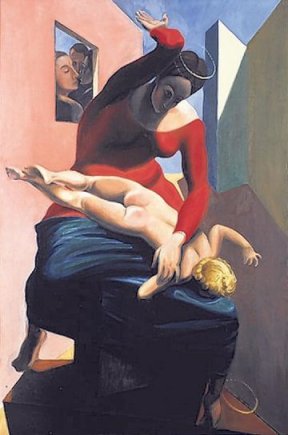|
The apocryphal childhood of Christ |
|
| Once the
Holy Family returned from Egypt, there is a gap in the Bible narrative
until the account of the twelve-year-old Christ disputing with the
doctors in the Temple. (Luke 2 v 42 - 51). The gap needing
filling, in this case by the various versions of The Nativity Gospel
of Thomas. To the modern reader this is an odd account, and, although known, it seems to have had little or no influence on art. It portrays Jesus as something of a spoilt brat, perfectly willing to murder his playmates simply for bumping into him: more magician that saviour. One rather more attractive passage describes the five-year-old Jesus making birds out of clay, birds that he eventually brings to life. This would make a good picture, but I don't know of one. The various versions of the infancy gospel can be read here. For artists, tackling this period of the life of Christ, the answer was - make it up. Probably the best known painting that does this - regrettably, in my view - is Christ in the House of his Parents by John Everett Millais. |
|
|
|
|
|
Why have I always disliked this picture? In this I am not alone; it
caused a furore when it was first shown for being too modern. To modern
eyes, it looks - well, dated. The figures are unattractive: a
sentimentally pretty Jesus, a rather sulky John the Baptist, an odd
Joseph whose arms seem much to long. Charles Dickens disliked the Mary
and described her as looking like an alcoholic, 'hideous in her
ugliness.' This seems just a little harsh. I think my problem with it is that its symbolism is all too obvious - Christ with the wounded hand like a stigmata, the tools on the back wall representing the Trinity and the instruments of the passion. One likes ones paintings to be a little more subtle. Gerrit van Honthorst's Childhood of Christ isn't that subtle either - watch what you are doing with that chisel, Joseph! |
|
|
|
|
| Not promising so far. So, on to two rather more interesting - and controversial - paintings. | |
|
|
|
|
Caravaggio's painting shows a young
Christ stamping on a snake, held by the virgin and with St. Anne looking
on. This almost certainly refers to Christ's preaching in Luke: And he said unto them, I beheld Satan as lightning fall from heaven. Behold, I give unto you power to tread on serpents and scorpions, and over all the power of the enemy: and nothing shall by any means hurt you. Notwithstanding in this rejoice not, that the spirits are subject unto you; but rather rejoice, because your names are written in heaven. (Luke 10 v 18 -21) The serpent is Satan, and the cause of the fall of man in the garden of Eden. Even at this young age, Christ in the redeemer. Rather obvious symbolism again? Well, perhaps. But what about Max Ernst? For obvious reasons this painting has caused outrage and offence. As a prime example of Dada, that was what is was about; these painters did their best to dislodge any halo they could find. And yet - is there more to this painting than that? Leo Steinberg in the New York Review of Books thinks so. He suggests that the painting refers to a folk memory of Christ's childhood, one we have met - in the Infancy Gospel of Thomas. Certainly, Christ's wickedness in murdering his playmates would deserve a spanking. (The Steinberg reference can be found here.) Curiously, The Infancy Gospel mentions a snake too: And Joseph sent his son James to bind fuel and carry it into his house. And the young child Jesus also followed him. And as James was gathering of faggots, a viper bit the hand of James. 2 And as he was sore afflicted and ready to perish, Jesus came near and breathed upon the bite, and straightway the pain ceased, and the serpent burst, and forthwith James continued whole. (Chapter XVI) An unlikely connection between the two paintings? I will leave you to decide! |
|



